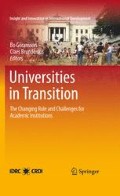Abstract
Tanzania is one of the poorest countries in the world, with about 50% of the population living below the poverty line. It is predominantly agrarian, with agriculture contributing about 50% to the gross domestic product (GDP) and engaging over 80% of the total population. Another significant contribution to the GDP comes from the service sector which contributes about 39.3%. The manufacturing sector, which is the most powerful engine of structural change and modernization of the economy, contributes only 7.6% to the GDP and accounts for less than 1% of total exports.
Access this chapter
Tax calculation will be finalised at checkout
Purchases are for personal use only
References
Chisawillo P (2006). Facilitating Metalworks Cluster, Proceedings of the 3rd Regional Conference on Innovation Systems and Innovative Clusters in Africa, Dar es Salaam, ISBN:9987-9074-4-X, pp. 174–187.
COSTECH (2005) A Report on the Survey of R&D Funds Flow In the Tanzanian Government R&D Institutions. Dar es Salaam.
Diyamett BD (2004). The Concept of Technological Innovation: Theoretical Overview and Some Practical Implication for Africa. In Mwamila BLM, Trojer L, Diyamett B and Temu A (eds) Innovation Systems and Innovative Clusters in Africa. Proceedings of a Regional Conference, Bagamoyo, Tanzania.
Diyamett BD (2005). A Mini-study to Test Tools Developed for Innovation Indicators and Surveys for the Tanzanian Manufacturing Sector. UNESCO, Nairobi.
European Commission. Proposed Guidelines for Collecting and Interpreting Technological Data – OSLO MANUAL. Organisation of Economic Cooperation and Development (OECD).
Joseph CC, Nkunya MHH (2002). Natural Products as Potential Environmentally Friendly Pesticides, Proceedings, International Science Symposium on Environment, Faculty of Science, University of Dar es Salaam, September.
Liwenga JM (1988) History of Agricultural Research in Tanzania. In Ter J.M and Mattee A.Z (eds), Proceedings of a Workshop on Science and Farmers in Tanzania, Sokoine University of Agriculture (SUA), Morogoro, Tanzania.
Mawenya AS (2002). Private Sector Participation in Financing of Higher Education. In Mwamila BLM, Omari I and Mbuya E (eds). Financing of Higher Education in Eastern and Southern Africa: Diversifying Revenue and Expanding Accessibility – Proceedings of A Workshop. Dar es Salaam, Tanzania.
MoHEST (2006). Basic Statistics on Higher Education, Science and Technology, 001/2002-2005/2006, Dar es Salaam University Press.
Shetto RM (2005). Agricultural Mechanization in Tanzania. A paper presented to the 3rd Annual Engineers’ Day 2005, Dar es Salaam, Tanzania.
UDSM (2005). Five Year Rolling Strategic Plan 2005/2006–2009/2010, The Institute of Kiswahili Research, Dar es Salaam.
URT (2000). National Development Vision; Vision 2025.
Wangwe SM, Diyamett B (1998). Cooperation between R&D Institutions and Enterprises: The case of United Republic of Tanzania. In atas XI-New Approaches to Science and Technology Cooperation and Capacity Building. United Nations, NewYork and Geneva.
Wangwe SM, Diyamett BD, Komba A (2003). Trends in R&D Activities in Tanzania: Funding Sources, Institutional Arrangements and Relevance. Research on Knowledge Systems (RoKS), IDRC.
Webmetrics International (2005). http://www.universitymetrics.com
Author information
Authors and Affiliations
Corresponding author
Editor information
Editors and Affiliations
Rights and permissions
Copyright information
© 2011 International Development Research Centre
About this chapter
Cite this chapter
Mwamila, B.L.M., Diyamett, B.D. (2011). Tanzania: The Evolving Role of Universities in Economic Development. In: Göransson, B., Brundenius, C. (eds) Universities in Transition. Insight and Innovation in International Development. Springer, New York, NY. https://doi.org/10.1007/978-1-4419-7509-6_9
Download citation
DOI: https://doi.org/10.1007/978-1-4419-7509-6_9
Publisher Name: Springer, New York, NY
Print ISBN: 978-1-4419-7508-9
Online ISBN: 978-1-4419-7509-6
eBook Packages: Humanities, Social Sciences and LawEducation (R0)

